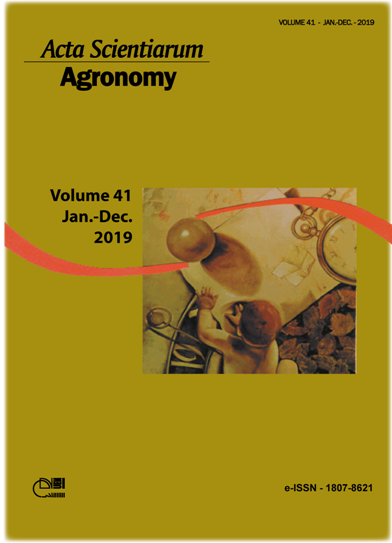Self-organizing maps in the study of genetic diversity among irrigated rice genotypes
Resumo
This study presents self-organizing maps (SOM) as an alternative method to evaluate genetic diversity in plant breeding programs. Twenty-five genotypes were evaluated in two environments for 11 phenotypic traits. The genotypes were clustered according to the SOM technique, with variable topology and numbers of neurons. In addition to the SOM analysis, unweighted pair group method with arithmetic mean clustering (UPGMA) was performed to observe the behavior of the clustering when submitted to these techniques and to evaluate their complementarities. Genotype ordering according to SOM was consistent with UPGMA results, evidenced by the basic structure of UPGMA groups being preserved in each group of the maps. Regarding genotype arrangement and the group neighbors, maps involving five neurons presented inferior organization efficiency compared to the six-map arrangements in both environments. It was observed that the organization pattern among the rice genotypes evaluated by the maps was complementary to the UPGMA approach, as observed in all scenarios. It can be concluded that self-organizing maps have the potential to be useful for genetic diversity studies in breeding programs.
Downloads
Referências
Akkiraju, R., Keskinocak, P., Murthy, S., & Wu, F. (2001). An agent-based approach for scheduling multiple machines. Applied Intelligence, 14(2), 135-144. DOI: 10.1023/A:1008363208898
Barbosa, C. D., Viana, A. P., Quintal, S. S. R., & Pereira, M. G. (2011). Artificial neural network analysis of genetic diversity in Carica papaya L. Crop Breeding and Applied Biotechnology, 11(3), 224-231. DOI: 10.1590/S1984-70332011000300004
Borém, A., & Nakano, P. H. (2015). Arroz: do plantio à colheita. Viçosa, MG: Editora UFV.
Cruz, C. D., Ferreira, M. F., & Pessoni, L. A. (2011). Biometria aplicada ao estudo da diversidade genética. Visconde do Rio Branco, MG: Editora Suprema.
Cruz, C. D. (2012). Princípios de genética quantitativa. Viçosa, MG: Editora UFV.
Fritzke, B. (1994). Growing cell structures – A self-organizing network for unsupervised and supervised learning. Neural Networks, 7(9), 1441-1460. DOI: 10.1016/0893-6080(94)90091-4
Godfray, H. C. J., Beddington, J. R., Crute, I. R., Haddad, L., Lawrence, D., Muir, J. F., … Toulmin, C. (2010). Food security: The challenge of feeding 9 billion people. Science, 327(5967), 812-818. DOI: 10.1126/science.1185383
Hosan, S. M., Sultana, N., Iftekharuddaula, K. M., Ahmed, M. N. U., & Mia, S. (2010). Genetic divergence in Landraces of Bangladesh rice (Oryza sativa L.). The Agriculturists, 8(2), 28-34. DOI: 10.3329/agric.v8i2.7574
Kohonen, T. (1990). The self-organizing map. Proceedings of the IEEE, 78(9), 1464-1480. DOI: 10.1109/5.58325
Kohonen, T. (2014). MATLAB implementations and applications of the self-organizing map. Helsinki, FI: Unigrafia Oy.
Liukkonen, M., Laakso, I., & Hiltunen, Y. (2013). Advanced monitoring platform for industrial wastewater treatment: Multivariable approach using the self-organizing map. Journal Environmental Modelling & Software, 48(1), 193-201. DOI: 10.1016/j.envsoft.2013.07.005
Louis, P., Seret, A., & Baesens, B. (2013). Financial efficiency and social impact of microfinance institutions using self-organizing maps. World Development, 46(1), 197-210. DOI: 10.1016/j.worlddev.2013.02.006
Matlab. (2010). Version 7.10.0 [Software]. Natick, MA: The Math Works Inc.
Mojena, R. (1977). Hierarchical grouping methods and stopping rules: an evaluation. The Computer Journal, 20(4), 359-363. DOI: 10.1093/comjnl/20.4.359
Mwasiagi, J. I. (2011). Use of SOM to study cotton growing and spinning. In J. I. Mwasiagi (Ed.), Self organizing maps – Applications and novel algorithm design (p. 89-94). London, UK: IntechOpen. DOI: 10.5772/14106.
Preisigke, S. C., Neves, L. G., Araújo, K. L., Barbosa, N. R., Serafim, M. E., & Krause, W. (2015). Multivariate analysis for the detection of passiflora species resistant to collar rot. Bioscience Journal, 31(6), 1700-1707. DOI: 10.14393/BJ-v31n6a2015-29300
Rabelo, H. O., Guimarães, J. F. R., Pinheiro, J. B., & Silva, E. F. (2015). Genetic base of Brazilian irrigated rice cultivars. Crop Breeding and Applied Biotechnology, 15(3), 146-153. DOI: 10.1590/1984-70332015v15n3a26
Ray, D. K., Mueller, N. D., West, P. C., & Foley, J. A. (2013). Yield trends are insufficient to double global crop production by 2050. PLoS ONE, 8(6), e66428. DOI: 10.1371/journal.pone.0066428
Sarlin, P. (2013). Decomposin the global financial crisis: A Self-Organizing Time Map. Patter Recognition Letters, 34(14), 1701-1709. DOI: 10.1016/j.patrec.2013.03.017
Silva, E. F., Silva, V. A. C., Guimarães, J. F. R., & Moura, R. R. (2011). Divergência fenotípica entre genótipos de arroz de terras altas. Revista Brasileira de Ciências Agrárias, 6(2), 280-286. DOI: 10.5039/agraria.v6i2a1183
Silva, A. R., & Dias, C. T. S. (2013). A cophenetic correlation coeficiente for Tocher’s method. Pesquisa Agropecuária Brasileira, 48(6), 589-596. DOI: 10.1590/S0100-204X2013000600003
Smith, K. A., & Ng, A. (2003). Web page clustering using a self-organizing map of user navigation patterns. Decision Support Systems, 35(2), 245-256. DOI: 10.1016/S0167-9236(02)00109-4
Soares, P. C., Soares, A. A., Cornélio, V. M. O., Reis, M. S., Morais, O. P., Cutrim, V. A., ... Silva, F. L. (2008). BRSMG Predileta: irrigated rice cultivar for lowlands in Minas Gerais. Crop Breeding and Applied Biotechnology, 8(1): 251-254. DOI: 10.1590/1984-70332017v17n2c27
Streck, E. A., Aguiar, G. A., Magalhães Júnior, A. M., Facchinello, H. K., & Oliveira, A. C. (2017). Variabilidade fenotípica de genótipos de arroz irrigado via análise multivariada. Revista Ciência Agronômica, 48(1), 101-109. DOI: 10.5935/1806-6690.20170011
Tilman, D., Balzer, C., Hill, J., & Befort, B. (2011). Global food demand and the sustainable intensification of agriculture. Proceedings of the National Academy of Sciences of the United States of America, 108(50), 20260-20264. DOI: 10.1073/pnas.1116437108
DECLARAÇÃO DE ORIGINALIDADE E DIREITOS AUTORAIS
Declaro que o presente artigo é original, não tendo sido submetido à publicação em qualquer outro periódico nacional ou internacional, quer seja em parte ou em sua totalidade.
Os direitos autorais pertencem exclusivamente aos autores. Os direitos de licenciamento utilizados pelo periódico é a licença Creative Commons Attribution 4.0 (CC BY 4.0): são permitidos o compartilhamento (cópia e distribuição do material em qualqer meio ou formato) e adaptação (remix, transformação e criação de material a partir do conteúdo assim licenciado para quaisquer fins, inclusive comerciais.
Recomenda-se a leitura desse link para maiores informações sobre o tema: fornecimento de créditos e referências de forma correta, entre outros detalhes cruciais para uso adequado do material licenciado.




















































